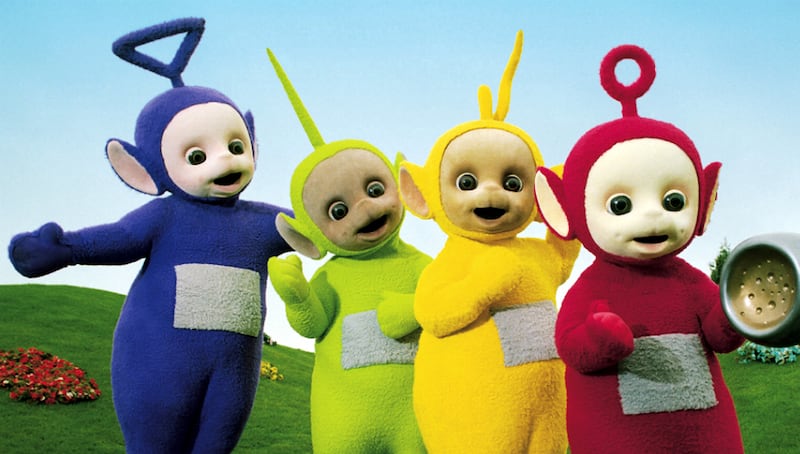I've been looking forward to the BBC's gritty HBO-friendly reboot of Teletubbies for some time (Monday to Friday, CBeebies). I was hoping that it'd be this decade's Battlestar Galactica. I wasn't disappointed.
Act 1: The sun rises over a spare and desolate landscape. The sun has a human face, which is, depending on what you’ve taken, delightful/nightmarish. There are rabbits and trees surrounding the Neolithic burial mound in which the Teletubbies dwell, but it soon becomes clear that the Teletubbies themselves are the apex predator in this unusual environment.
Out they come – obese, furry, hazmat-suit-wearing innocents with arcane symbols on their heads and a limited vocabulary.

“Tinky Winky says hello to Dipsy,” explains God/the narrator.
“Eh oh, Dipsy” says Tinky Winky.
“Dipsy says hello to Laa-Laa,” says God.
“Eh oh, Laa-Laa,” says Dipsy.
This goes on for some time.
After the nuclear winter
Over the course of each episode the Teletubbies toy with beloved items – a scooter, a handbag, a hat, a watering can. Observant viewers, however, will note that there is no sign of the industrial society required to make such things. They are remnants of the old world.
In another episode, Dipsy waters his friends’ chosen artefacts with his watering can causing them to grow big, thus demonstrating the manner in which physics operates now.
The writers are not afraid to deal with contemporary issues either. In one episode, the Teletubbies are distracted by the emergence of flowers. Po's favourite flower is a red flower that looks very like a poppy. The rest of the Teletubbies choose differently coloured flowers, presumably because they hate the troops. Not to chip in with too much back story, but I suspect that in the immediate aftermath of Threads (the 1984 Bafta-winning prequel to the Teletubbies) the Teletubbies had good reason to hate the military.
The Teletubbies are not entirely alone. They receive occasional direction from the actor Jim Broadbent via a communications periscope jutting from the ground. This leads, I presume, to the bunker where he and the last of the humans live.
Broadbent’s character is unnamed, so I’ve decided it’s the civil servant he plays in the excellent BBC spy drama London Spy (BBC, Monday), which also started this week. It’s clear from the way he talks to the Teletubbies that he likes them, but ultimately fears them and how they have inherited his world. He’s no fool. He will not be lured from the protection of his bunker by their childish horseplay.
The quartet also, ominously, get signals beamed from a nearby windmill. The way it’s shot suggests that this is a clue to what has happened to the world we know. Yes, it was the windfarms. The windfarms went mental, thus ending the age of man and ushering in the age of Teletubby. The communications from the evil windmill usually involve the human children who are trapped in the Teletubbies television stomachs. These brave tots are doomed to replay the same actions again and again. But the Teletubbies don’t mind. They enjoy Beckettian levels of repetition. For example, in the third episode this week, Dipsy chooses to repeatedly ride the lift in their hovel rather than answer the telephone to Jane Horrocks. He answers it eventually.
Jane Horrocks just wants to tell the Telletubbies to dance. The horror has driven poor Jane Horrocks mad. I hope she’s in the bunker where Jim Broadbent can look after her.
Most British children's programmes have a strong ideological message at their heart. Bob the Builder, for example, is a Thatcherite paean to free-enterprise and self-sufficiency, while Fireman Sam is a cutting satire of public spending and the interfering nanny state (in Bob the Builder's world, troublemaking urchin Norman Price and the other flammable freeloaders of Sam's home, Pontypandy, would be left to die as nature clearly intended).
The message of Teletubbies is ultimately a positive one: support nuclear power (as represented by the baby face at the core of the sun); do not listen to the evil windmill; heed wise Jim Broadbent as he speaks from his cave of sorrow; and trust that you'll always be able to build a life for yourself in the ruins of your parents' world. Eh oh, indeed.
Tragedy repeated is comedy
Speaking of Beckettian dystopias, has an academic ever suggested that the two acts of Waiting for Godot are back-to-back pilots for a situation comedy? If not, I bags that thesis and an honorary doctorate from Teletubbies' University.
Comedy is tragedy repeated in 30-minute chunks. The ever brilliant, also returning Peep Show (Wednesday, Channel 4) is arguably 24 times better than Waiting for Godot because it has thus far repeated its depressing conceit – that its POV heroes are barred from happiness by their own dysfunctional personalities – 48 times.
It’s still very, very funny. Mark (David Mitchell/uptight/ ashamed/morally weak) and Jez (Robert Webb/deluded/ shameless/weakly amoral) reunite for Super Hans’s stag party (and yes there are mild spoilers ahead). Jez is living in Super Hans’s toilet. Mark is working for Johnson in the bank and avoiding his new William Morris-obsessed flatmate by playing Candy Crush on the toilet (“This is the confusing highpoint of western civilisation”).
By the end of the first episode, they’re back living together in co-dependent misery, because, frankly, we wouldn’t enjoy them if they were happy. Oh, and Super Hans starts the episode “on the juice” and ends up back on the cocaine.
Prediction: if we ever get an episode of Peep Show from Super Hans's point of view, the sun will have a smiling baby's face.












